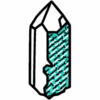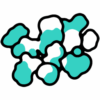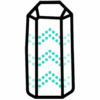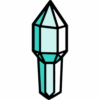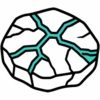Druzy Crystals
 What Makes Druzy Crystals So Special?
What Makes Druzy Crystals So Special?
Have you ever picked up a stone that glittered like starlight scattered across its surface – as though an entire galaxy had been captured in your palm? That’s druzy (also spelled druse).
A druzy crystal isn’t a single stone, but rather a surface blanketed in thousands of tiny crystals that form naturally atop another mineral. Imagine a rock’s inner cavity or crevice slowly filling with mineral-rich water. As time passes and the water evaporates, what remains is a delicate crust of sparkling micro-crystals – a glittering frost left behind by the slow artistry of nature.
This fine crystal layer can form on a variety of host stones – quartz, agate, chalcedony, and even calcite. Unlike solid crystal clusters that grow outward, druzy is more like a crystal skin, coating its base with a sugar-like sparkle that catches light from every angle. Each piece looks as if dusted with magic – which might explain its lasting appeal in both geology and metaphysics.
The word druzy comes from the German Druse, meaning “cavity” or “crystalline crust.” It’s an apt name – and also a metaphor. Many see druzy as a symbol of inner light: a reminder that brilliance can bloom quietly beneath the surface, one tiny crystal at a time.
Nature’s Glitter Factory
Ever wonder how something so dazzling could come from ordinary rock? The secret lies in slow patience and perfect conditions. Druzy crystals form when groundwater rich in silica or other minerals seeps into small pockets within a rock. Over time – sometimes thousands or even millions of years – the water evaporates. Left behind are mineral deposits that slowly crystallize into a fine, sparkling layer.
Temperature, mineral content, and even the tiniest shifts in pressure can influence how a druzy forms. In volcanic rocks, for example, the crystals might grow inside gas bubbles trapped during cooling. In sedimentary environments, mineral-rich solutions fill cracks and voids within softer stones. The result? A range of textures – from fine-grained druse that glitters like powdered sugar to coarse druzy that looks almost like a bed of crushed diamonds.
The color variations are equally mesmerizing. Pure quartz druzy may appear white or clear, while mineral impurities create soft hues of lavender, gold, or blue-gray. Some are later treated – vapor-coated with metals like titanium or cobalt – to produce vivid rainbow effects. While natural tones have an understated beauty, these enhanced varieties shimmer with an otherworldly iridescence that feels almost cosmic.
Whether found in the volcanic caverns of Brazil or within the layered agates of Uruguay, druzy is nature’s reminder that transformation happens slowly – and that sometimes, beauty forms in the quietest corners of the earth.
Types and Varieties of Druzy
If all druzy sparkles, what makes each one unique? The answer lies in its host mineral – the foundation upon which its glittering crystals grow.
Quartz Druzy is the classic – clear, white, or faintly tinted. It’s what most people picture when they imagine druzy: a fine frost of light-catching brilliance. Amethyst Druzy takes things deeper, coating a violet base with tiny purple crystals known for soothing energy and emotional balance.
Then there’s Agate Druzy, where sparkling quartz crystals sit atop colorful, banded layers of agate – a blend of structure and shimmer. Chalcedony Druzy offers a softer aesthetic: pastel blues, creams, and pinks that glow gently rather than flash. On the bolder side, Calcite, Pyrite, or Cobalt Druzy can appear metallic, giving off golden or silvery sheens that look almost like crystallized starlight.
Color, too, tells a story. Some druzy stones remain in their natural earthy hues – ivory, gray, champagne – while others are enhanced to radiate electric blues, rainbow auroras, or deep golds. Titanium-druzy, for instance, gleams with oil-slick iridescence after being coated with metallic vapor. While purists often prefer the natural tones, many crystal lovers enjoy the energetic intensity of these treated varieties – vibrant reminders of the union between nature and artistry.
Druzy deposits are found worldwide, but each region leaves its fingerprint. Brazil and Uruguay produce lush amethyst druses within geodes. India’s chalcedony druzy often displays serene pastels. Morocco’s specimens shimmer with earthy mystery, while the U.S. (particularly Arizona and Nevada) yields rugged, wild-textured varieties. Each piece, no matter its origin, captures a fleeting moment of geological stillness – frozen light sculpted by time.
Ancient Spark and Modern Wonder
Long before druzy became a favorite of modern jewelry designers, its glittering surfaces caught the attention of ancient eyes. While the term druzy itself is modern, similar crystalline crusts have appeared in adornments and sacred artifacts throughout history. Ancient healers and shamans often used druzy-coated stones to symbolize divine light – a physical embodiment of the cosmos within the earth.
In many traditions, stones with fine crystal layers represented unity through multiplicity – countless tiny crystals working together as one radiant surface. This symbolism resonated deeply with those seeking harmony, community, and collective strength. Some even placed druzy-like stones near temple altars, believing their soft shimmer invited spiritual presence and purity.
Fast-forward to today, and druzy has found a new form of reverence. Jewelers prize it for its natural sparkle and texture – no faceting required. Designers love the way it blurs the line between the raw and the refined. And metaphysical practitioners continue to see in druzy what ancient cultures once did: a reflection of inner brilliance and the quiet power of cooperation.
When light hits a druzy, it doesn’t just sparkle – it seems to breathe. Perhaps that’s why it still captivates us: each shimmer feels like a small reminder that beauty, like healing, often begins with the smallest of steps – one crystal at a time.
Energetic and Metaphysical Properties
How can something so small hold so much energy? Druzy crystals, with their countless micro-points, are said to amplify energy – both from the person using them and from the stone beneath their sparkling layer. It’s as if every tiny crystal acts like a miniature prism, catching, refracting, and multiplying light.
Metaphysically, druzy represents collective energy. Each micro-crystal contributes to the stone’s overall vibration, creating a harmonic field of gentle yet powerful resonance. People who feel drained, scattered, or overstimulated often turn to druzy for its balancing effect. It’s thought to calm the mind while subtly uplifting the spirit – a quiet reset for the soul.
Druzy is also seen as an emotional amplifier. When placed on the heart or held during meditation, it may help dissolve emotional stagnation, encouraging clarity and self-expression. In crystal healing circles, it’s often described as an “energetic harmonizer” – helping different aspects of your life, relationships, or chakras work together in resonance rather than conflict.
The color of a druzy often refines its energetic tone.
- Amethyst druzy encourages intuition, calm, and spiritual connection.
- Quartz druzy purifies and amplifies intention.
- Rainbow or titanium druzy energizes creativity, joy, and confidence.
Each spark seems to whisper the same message: you are multifaceted, and every facet matters.
From Meditation Mats to Runways
How can you bring this glimmering wonder into your daily life? Druzy is as versatile as it is beautiful.
In crystal healing, druzy stones are often placed in meditation spaces or healing grids to boost energy flow. Their reflective quality brings brightness to dim corners – both literal and emotional. Many practitioners use druzy quartz to enhance group meditation sessions, believing it helps unify collective energy and deepen calm focus.
When it comes to personal adornment, druzy’s popularity has exploded. Its natural shimmer makes it ideal for earrings, pendants, and statement necklaces. Unlike faceted gems that rely on cutting for brilliance, druzy’s raw sparkle is inherent – nature’s own design. Because its surface can be delicate, it’s best used for jewelry that experiences less wear (like earrings and pendants rather than rings).
Beyond aesthetics, many wear druzy jewelry as a daily talisman – a portable reminder to stay centered and radiant amid stress. Its light-catching surface feels almost symbolic of emotional resilience: no matter how dull the day, druzy finds a way to shine.
Genuine Sparkle
In a marketplace full of shimmer, how can you tell what’s real? Recognizing natural druzy is partly about observation – and partly about intuition.
Natural druzy tends to have an earthy subtlety. Its crystals vary slightly in size and reflectivity, and the sparkle feels organic rather than mirror-like. The tones are often soft – silvery whites, champagne, or muted pastels. Treated druzy, on the other hand, has a vivid metallic sheen – cobalt blue, gold, or rainbow hues – produced through electroplating with titanium or other metals. Both are real stones, but one carries its natural tone, while the other is artistically enhanced.
Quality indicators include even crystal coverage across the surface, secure attachment to the base mineral, and intact points without dull or broken areas. A high-quality druzy feels both luminous and stable – you can sense its delicacy without it seeming fragile.











